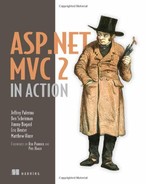Foreword to the First Edition
The final version of ASP.NET MVC 1.0 was released March 2009 during the Mix 09 conference and nobody was caught by surprise with what was inside—and this is a good thing. Before the debut of the final version, the product team had released multiple public previews with full source code in an effort to raise the bar on openness and community involvement for a Microsoft product.
Why would we do this?
Transparency and community involvement are noble goals, but they aren’t necessarily the end goal of a project. What we’re really after is great product. I like to think of ASP.NET MVC as almost an experiment to demonstrate that transparency and community involvement were great means to achieving that goal.
After Preview 2 of ASP.NET MVC was released, we received a lot of feedback from developers that writing unit tests with ASP.NET MVC was difficult. Jeffrey Palermo, the lead author of ASP.NET MVC in Action, was among the most vocal in providing feedback during this time. We took this feedback and implemented a major API change by introducing the concept of action results, which was a much better design than we had before. Community involvement helped us build a better product.
ASP.NET MVC focuses on solid principles such as separation of concerns to provide a framework that is extremely extensible and testable. While it’s possible to change the source as you see fit, the framework is intended to be open for extension without needing to change the source. Any part of the framework can be swapped with something else of your choosing. Don’t like the view engine? Try Spark view engine. Don’t like the way we instantiate controllers? Hook in your own dependency injection container.
ASP.NET MVC also includes great tooling such as the Add View dialog, which uses code generation to quickly create a view based on a model object. The best part is that all the code generation features in ASP.NET MVC rely on T4 templates and are thus completely customizable.
With this book, Jeffrey will share all these features and more, as well as show how to put them together to build a great application. I hope you enjoy the book and share in his passion for building web applications. Keep in mind that this book is not only an invitation to learn about ASP.NET MVC, but also an invitation to join in the community and influence the future of ASP.NET MVC.
Happy coding!
PHIL HAACK
SENIOR PROGRAM MANAGER
ASP.NET MVC TEAM
MICROSOFT
